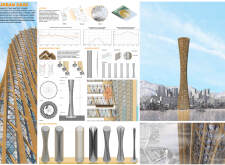5 key facts about this project
The "Urban Oase: Harvesting Water Tower" is located in Sokcho-si, Gangwon-do, Korea, and responds to the environmental issues that modern cities face. The setting includes mountains on one side and the eastern coastline on the other, creating a unique backdrop for the structure. The design emphasizes flexibility and transformation, aiming to create a building that can adapt to changing climate conditions, particularly the area's high humidity and frequent fog.
Design Concept
The central idea behind the Harvesting Water Tower focuses on adaptability. The architecture is meant to be light and flexible, allowing it to respond effectively to the specific needs of its environment. By emphasizing these qualities, the design aims for a structure that maintains functionality while adjusting to the climatic variations characteristic of Sokcho-si.
Materials and Sustainability
Timber is chosen as the main material for the structure, reflecting a focus on environmental sustainability. This lightweight and prefabricated option enables the building to be both resilient and adaptable. The use of wood supports the creation of semi-permanent spaces that can change according to user demands and environmental factors, presenting a sustainable solution within urban settings.
Spatial Organization
The layout of the Harvesting Water Tower features various interconnected spaces that encourage community interaction. This thoughtful arrangement integrates communal areas with functional elements, enhancing the building's overall versatility. By creating areas that serve different purposes, the design fosters a strong connection between inhabitants and the surrounding landscape, making it a part of the local environment.
Environmental Interaction
A notable aspect of the project is its harvesting system, designed to engage with the local climate. This system efficiently captures fog and rainfall, using these natural resources to support the building's needs. Through this approach, the structure not only addresses the requirements of its users but also emphasizes a commitment to ecological considerations. The design reflects an awareness of its surrounding context, highlighting the importance of sustainability in urban architecture.
Overall, the building features distinct elements that facilitate the collection of natural resources, visually connecting it to the landscape while serving a practical purpose.


















































